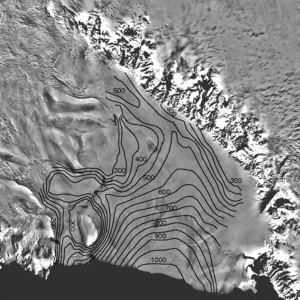A wall of iceWhen approaching Antarctica by sea one is met by an inhospitable wall of ice several tens of metres high – the barrier.

“It is difficult to capture in writing any sense of the impression this mighty ice wall makes,” wrote Amundsen. Most of Antarctica is surrounded by ice floating on the sea. It is nothing like the sea ice we find in the Arctic, which is a few metres thick, but rather several hundred metre thick glaciers that flow down from the inland ice sheet like a river and spread out over the sea in what is called an ice shelf. The ice shelves in the Ross Sea and the Weddell Sea, on the other side of Antarctica, are two of the largest. Our course now leads us 700 km across the Ross Ice Shelf before we begin our ascent to the plateau. For sheer scale, Antarctica is unsurpassed! Getting up onto the ice shelf was a huge challenge for the early expeditions. Nowadays, helicopters are used to unload the cargo that supply ships bring in for the research stations. Roald Amundsen was obliged to locate a place where the ice shelf did not tower quite so high. Descriptions from earlier expeditions had convinced him that there was some kind of valley in the dreaded barrier at the Bay of Whales. With reverence, Amundsen describes the barrier: “The mythical barrier! All accounts, without exception, from the time our blessed predecessor Ross right through to our day, have described this mighty natural phenomenon with fearful awe. It was as though the same words could always read between the lines: ’Hush, keep silence! – the mythical barrier!’ ” The ice flows continuously seaward, calving huge rectangular icebergs at the edge. These icebergs are often several kilometres long and stick out to 30–40 metres above the sea surface. About 90% of the iceberg is under water because the density of pure ice is about 920 kg/m3 whereas the density of seawater is about 1025 kg/m3. In the middle of the Ross Ice Shelf, the ice moves about 1 km per year. The speed along our route is somewhat lower, but when we get up in the morning we will be 1 m farther north than when we went to bed. Amundsen’s base camp undoubtedly ended its days on a northbound iceberg that melted away. Framheim went to the bottom of the sea long ago. Did you know that Norway has a long history of Antarctic research?
For over a century, Norwegians have been doing research in Antarctica. It started with Carsten Borchgrevink, who outfitted an expedition team consisting of Norwegians and scientists in 1898. The expedition received its financing from England. |
South Pole 1911–2011 is an informational outreach project run by the Norwegian Polar Institute
Contact person:


